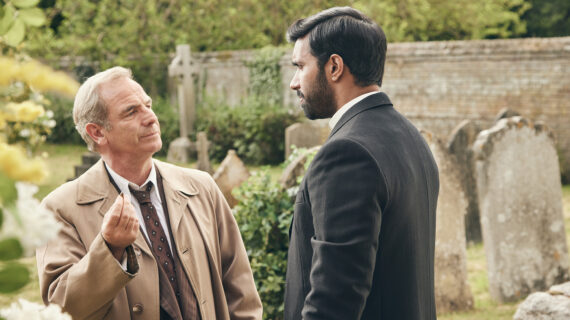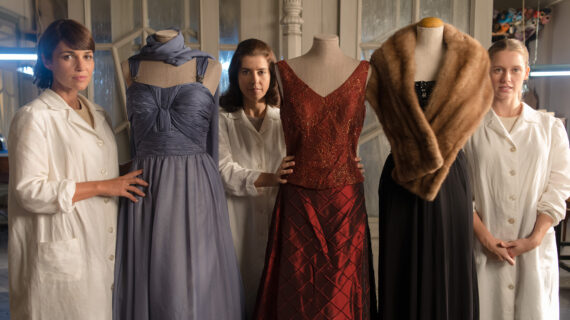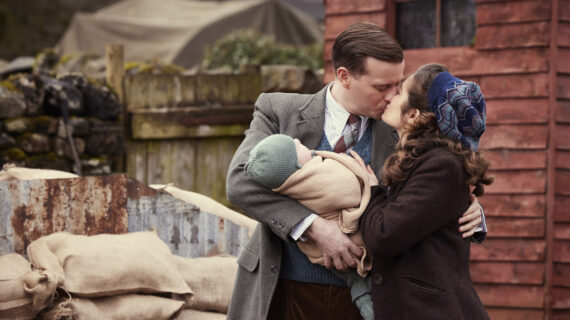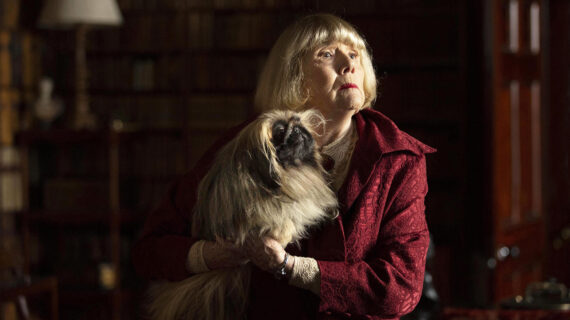[Katie Schumacher, Wisconsin Historical Museum]
Today, we are pleased to introduce Amy Rosebrough as part of the Wisconsin Historical Museum’s History Sandwiched In lecture series. Amy has worked at the Wisconsin Historical Society in the State Archaeology and Maritime Preservation Program since 2000. She received her PhD at U.W.-Madison in – in 2010, and the focus of her research was the effigy mound phenomenon of Wisconsin. Prior to that, Amy worked in the private sector for some years and conducted research at sites from Arkansas to South Dakota. Here today to share her perspective on Wisconsin effigy mounds, please join me in welcoming Amy Rosebrough.
[applause]
[Amy Rosebrough, Archaeologist, Wisconsin Historical Society]
Thank you very much. The mic is on. Everyone can hear me? Alright.
Well, we are here today to talk about a very timely subject for a number of reasons. First of all, you may have seen articles about effigy mounds and effigy mound preservation in the news in the past few months, and so I’m glad to be able to come and bring out some information that you may have seen in media and may not have with regard to how important these sites are. And secondly, because this is Wisconsin archeology month. So, hooray!
[laughter]
We’re going to be having all kinds of events in the next month, and if you go to our calendar at WisconsinHistory.org, you should see many wonderful things to do around the state. And you could perhaps even visit some of these sites yourself and see them for yourself.
Alright. So, what is an effigy mound?
[slide titled, What is an effigy mound?, and featuring the definition – a mound shaped like an animal or spirit and built between A.D. 750-1200. The slide itself is an illustration of several effigy mounds]
We’ll start with the basics. And effigy mound is a burial mound made out of Earth. It’s a sculpture. It’s a funerary monument.
Effigy mounds are unlike other mounds in that they’re shaped like animals or spirits. It could be birds. It could be bears. It could be even human form.
[Amy Rosebrough, on-cam]
And they’re built by a group of people we call Late Woodland between A.D. 750 and 1200. Wisconsin is the center of the effigy mound phenomenon. There are a few in Iowa, a few in Minnesota, a few in Illinois. Just kind of the tear of counties that adjoin us. But, for the most part, they’re here in Wisconsin, which is why it is not fair at all that Iowa has Effigy Mounds National Monument. That should be ours.
[laughter]
[slide titled, Schaeffer Bird Effigy, Richland County, featuring a photo of a Bird Effigy Mound]
So, here is what they look like. This is one of the few photos I’ve got where you actually see the bird shape. That’s only because it’s flooded. If you try and take a photo of these, they drop into the ground. They – they disappear. So, you see the tail is pointed at the camera, and the wings are off to either side.
[new slide titled, Spencer Lake Mound, Burnett County, featuring a black and white photo of a Burial Mound]
The effigies are different from the other mound forms. Conical mounds are the most common type of mound in Wisconsin. This is what our state archaeologist refers to as a Great Big Mound up in Burnett County. Most conicals are considerably smaller than these.
[new slide titled, Lizard Mound Park, Washington County, featuring a photo of a Linear Mound taken in the Autumn]
Linear mounds were also made by the effigy builders. They’re a little more recent in time. Linear are part of a class of mounds –
[Amy Rosebrough, on-cam]
– that we call geometrics. They’re long. They sometimes have projections and angles and bends to them. They may have conical components to them, but they don’t appear to represent living beings, or at least not beings we can recognize.
And then accompanying mounds –
[slide titled, Whistler Enclosure, Waushara County, featuring a photo of an enclosure in the woods of Waushara County]
– at some sites are other Earthworks such as enclosures. This is the Whistler Enclosure up in central Wisconsin. It probably represents a dance ground. You’re looking at the green oval in the middle, which is the innermost edge of the dance ground, and you can just barely make out, around here, the outer ring. So, you can imagine dancers in between those two embankments conducting ritual and dancing as part of ceremonies related to the mounds.
[new slide featuring a color-coded map of Wisconsin indicating the distribution of effigy mounds in the state, with Great big mounds in purple located in the northwest parts of the state, small mounds in tan located in the northeast parts of the state, and effigy and other mounds in brown located in the entire southern and central parts of the state and along the Mississippi river to around LaCrosse]
The effigy mounds are, for the most part, concentrated in southern Wisconsin, and Madison sits at the – the epicenter of it. We’re right here in the middle. There are mounds at the northeastern Wisconsin. I’ve tagged them –
[Amy Rosebrough, on-cam]
– the small mound area. They’re conical and linear in form with a few other geometrics, but they’re usually fairly low and pretty sparse. And then up in south – northwestern Wisconsin are the great big mounds, and those are big conical and oval and low shaped mounds that is , again, our state archaeologist says can be as big as a Buick.
[laughter]
[slide featuring an aerial photo of the Wehmhoff Panther effigy mound in Kenosha county with a road running through it and the statistic that – Though over 3000 effigy sites once stood in Wisconsin, fewer than 10% are left, and even fewer are undisturbed]
We have records of over 3,000 effigy mound sites in Wisconsin. Each one could contain one effigy mound, sometimes up to hundreds. Most of those, however, are gone. They were plowed away in farms fields. Roads were cut through them. They were taken out in quarries. Cities were built on them. Maybe 10% of what used to be here is left, and of those, most have suffered damage in one way or another. So, we have very few pristine examples of effigy mounds left, which is a real shame because, as we’ll see, each mound is a unique work of art and a unique representation of ancient belief systems, and each is a sacred place to today’s native peoples and to others who respect the history and honor –
[Amy Rosebrough, on-cam]
– those who came before.
So, who built them? In the 1800s, there was a great controversy. The lost race of mound builders.
[slide titled, Who built the mounds, featuring three photos, two of a death mask found in Rice Lake, Wisconsin, and one of a rock shaped like a head dubbed Mr. Head from Iowa County]
You would have seen that phrase repeated in the literature. And the builders were tagged as anyone from Phoenicians to Romans to the lost tribes of Israel. The idea was that, well, if you ask a currently living native person who built this, a lot of time you wouldn’t get an answer. That means they didn’t build it, and if they didn’t build it, someone else must have built it. And if somebody else built it and the natives are here, then that means they took over the land, so we can take it back. And it’s all okay.
Well, in the late 1800s, the Smithsonian Institution sent out archaeologists to cover the eastern half –
[Amy Rosebrough, on-cam]
– of the country and open mounds to try and settle the issue: Who were the mound builders? And, surprise, surprise, it turned out it was native peoples. They found portraits of native peoples, native pottery, native skeletal remains. And the race of the mound builders poofed away into history with that.
These are native creations.
These are the only portraits that we have of actual mound builders in Wisconsin, just a couple.
[return to the Who built the mounds slide]
The one in – at the lower corner, the death mask, is from the great big mound area up in northwestern Wisconsin. That appears to actually be a clay funerary mask. So, that’s an actual person. Mr. Head was found in the driftless area in Iowa County at a – what appears to be a religious shrine dating to the period of effigy construction. So, he may be our only portrait of an effigy builder. And it has been pointed out that the painting on his face – if – if you can see the stripes and the circle on his chin – that painting is identical to funerary face paint for the Ho-Chunk Bear Clan a thousand years ago.
[new slide tilted, Cast of Characters, featuring a photo of a conical mound and the bullet point – Early and Middle Woodland (500 B.C. – 500 A.D.)]
So, the first mounds in Wisconsin were built around 500 B.C. We call those folks Early Woodland people. We don’t know what they called themselves, and there were probably many different groups in Wisconsin building mounds. They’re succeeded a little while later by a group we call Middle Woodland, who also built conical mounds –
[new slide featuring a photo of a linear mound and the bullet point – Late Woodland (750-1200 A.D.)]
– and then, around A.D. 750 or so, by people who built effigy mounds. With each succession, funerary ritual and mound ritual changed just a little bit.
The effigies were a major innovation, and they appear –
[Amy Rosebrough, on-cam]
– to have kind of turned mounds inside out, as we’ll see.
And then there’s these folks – the Cahokians. They show up here around A.D. 950 –
[new slide in the Cast of Characters set, featuring a painting of a Cahokian village and the bullet point – Cahokians (a.k.a. Middle Mississippians) noting that they are platform mound builders, immigrants, and agents of change]
– or so and have a big impact on effigy mound construction in Wisconsin.
[new slide featuring five photos and an illustration – the illustration is of a Cahokian village and the photos are one of a single arrowhead, one of a set of four arrowheads, one of a pottery bowl, one of a hooked spearhead, and one of a set of five bowls]
For most of the period of mound building, communities would have looked a lot like this. Temporary seasonal camps with structures that could be easily dismantled and erected and moved if necessary. So, wigwam type structures. Very few traces left behind. Archaeologists call these ephemeral sites. It is where people were there and then they left, and they really didn’t leave much in the way of material culture behind to tell us about their lives.
We know that they hunted during the period of effigy construction with bows and arrows, that they gathered seasonally to harvest mussels from the rivers and nuts from the uplands. We know that they fished. We know that they traded for stone from Silver Mound in Jackson County. But other than that, their lives are a pretty big mystery.
[new slide titled, Late Woodland Communities, featuring a map of Wisconsin with the Late Woodland village sites indicated by red stars and located along the middle Wisconsin river and then south and east from there to west of Milwaukee and south to the Janesville-Rock River area]
We can map out the distribution of the Late Woodland effigy builder communities by mapping the mounds. And when we do that, we find that they fall into clusters represented by the green shading on the slide. Some of these, not coincidentally, match the location of modern communities in Wisconsin, like Madison and Milwaukee, Racine, Kenosha, La Crosse, Prairie du Chien, because a good place to live then is a good place to live today.
[Amy Rosebrough, on-cam]
The red stars represent a phenomenon that began to happen a little bit before A.D. 1000 that we call the Kekoskee phase. Corn is introduced into Wisconsin around that time, and some communities begin to take those first steps towards settling down and establishing year-round habitation, year-round villages.
Kekoskee communities –
[slide titled, Kekoskee Keyhole Structures, featuring a photo of the Statz site in Dane County of the remains of a Kekoskee village and an illustration of the type of wigwam type of building that the Kekoskee built as dwellings]
– contained what are called keyhole house structures. They looked a little bit like igloos except made out of a wigwam frame and with matting or hide or bark covering. The slide on that side of the screen [indicating the photo] is the actual floor of one of those houses. Now, you can imagine, you guys have Hoover vacuums. You know how the dirt accumulates on the floor, especially if you’ve got kids. This is what’s going on there. That’s the actual stain left behind by the house.
[new slide titled, Weisner III, Doge County – a late effigy mound village, featuring an illustration of said village with the huts outlined in red and storage pits indicated in blue at a ratio of 10 pits per hut at this location as well as black dots along the perimeter indicating post molds]
In a few places, we’ve got a little broader view of the community. This is a stripe that cuts through a – a village site when a utility project was going in. The archaeologist hired to monitor that found not just two keyholes structures, shown in red, but very large storage pits. Those are the blue blobs. And then those little black dots are post molds. And the arrangement there tells us that this village was fortified. They’d put a defensive wall up around it, which is something that tends to occur when people begin to settle down –
[Amy Rosebrough, on-cam]
– in one place all year. They begin to defend the village, defend the site.
And they were lucky enough – this stripe, this excavation, actually cut across the entrance. So, you see that line of double posts there.
[return to the Weisner III slide]
That is a fortified entrance. Anyone wanting to go in and/or out of that village would have had to squeeze through that wall and be isolated. It’s a single file kind of entry system.
[new slide titled, White Potato Lake Garden Beds, Oconto County, featuring a photo of potato beds in a forested area]
And they gardened. They began to devote more time to agriculture around this period as well. So, the corn hills that you might hear about in the historic period at that point were ridges. What we call ridged gardens or raised fields. This is a site up in northeastern Wisconsin where they’re preserved. And you see the green stripes. Hoop, hoop, hoop. Each of those represents a raised ridge on the ground. Corn would have been planted across the top of that, and then squash in the rows in between them, along with other plants like sunflowers and goosefoot.
Now, how many of you have heard of the three sisters? Okay, so, beans. Beans are missing. We only had two sisters at this point. Beans come in later.
[new slide titled, Differences in – how and where people lived, who they traded with and married, and how their lives changed, featuring a topological map of Wisconsin and indicating the major effigy tribes, with the Northern Tier in the North, the Horicon/Kekoskee in the Southeast, the Keyes/Eastman in the southwest/driftless area, and the Lewis along the Mississippi river north of the Keyes/Eastman]
Over time, effigy mound life diverged. And you see multiple areas where everyone’s kind of having their own take on how life should go. The Kekoskee people are settling down in southeastern Wisconsin. The folks of the driftless area are very conservative, and I won’t make that joke.
[laughter]
Okay.
The Lewis phase people are looking towards Minnesota, as they do today. And then we’ve got the northern and southern tier of effigy mound. We really don’t know much about them because there haven’t been that many excavations at those sites.
[Amy Rosebrough, on-cam]
Alright, so, what do the mounds tell us? A lot.
This is the Schadewald group.
[slide titled, The Mounds, featuring an aerial photo of a group of effigy mounds in Richland County]
It’s publicly accessible in Richland County, just north of Muscoda. So, go online, find out about this, make a trip. It’s one of the finest views in the driftless area from the top of this hill.
[new slide featuring a topographical map of Wisconsin with all the effigy mounds indicated by red dots mostly along the Mississippi river, and southern and central Wisconsin. Along the left-hand margin of the slide are five effigy mound shapes]
Alright, each of these dots represents one site, one place, where effigy mounds have been recorded. And again, they’re mostly over southern Wisconsin. Almost always near water. A major water source. Water was very important, not just to life, for travel and for drinking water and for resources, but from a religious standpoint as well. The path of the dead was said to begin in water.
[new slide featuring an illustration of a cross-section of an water panther effigy mound and three photos of items located within the mounds – one of pottery, one of burned stones, and one of an arrowhead]
And these are funerary monuments and sculptures. So, there’s a hypothetical cutaway into a water panther formed mound. You’ll see the burial feature is at the heart of the animal. If it were alive, that’s where the burial is placed. So, the burial, the person buried there becomes one with the creature and with its spirit.
Inside, you’re not –
[Amy Rosebrough, on-cam]
– going to find much in the way of artifacts. Out of all the effigy mounds ever opened, we’ve got reports of four pots. That’s it. And handful of stone tools, including the knife shown there, and then, from time to time, much more common, clusters of burned stone. Not burned inside the mound but burned someplace else and then gathered and placed in the mound. And these may represent light and fire and heat to accompany the deceased.
[slide titled, Devils Lake State Park – Baraboo, Wisconsin, featuring an aerial photo of a bird shaped effigy mound there]
They come in all different kinds of forms. So, we’ve got an aerial view of the Devil’s Lake bird. And you can see one wing is kind of hiding in the trees. But you see it’s got a long, forked tail. He may represent a swallow or a raptor that used to live in Wisconsin called swallow-tailed kite.
[new slide titled, Observatory Hill – U.W.-Madison, Madison, Wisconsin, featuring an aerial photo of a two tailed turtle effigy mound there]
Our famous two-tailed turtle on Observatory Hill here on campus. The only one of his kind.
[new slide titled, Goose Mound – Dane County, featuring an aerial photo of a goose shaped effigy mound near Madison, Wisconsin]
Goose Mounds, this is a Madison formed goose distinguished by the zigzag wings. The only place in Wisconsin where you find them. It’s a style particular to this area.
[new slide titled, Man Mound County Park – Baraboo, Wisconsin, featuring an aerial photo of said man shaped effigy mound in central Wisconsin]
Our famous Man Mound. It’s on the poster for this year’s archaeology month.
[new slide titled, Panther Intaglio – Fort Atkinson, Wisconsin, featuring a photo of an inverted panther shaped effigy mound]
And then odd things like this. This is an intaglio. It’s an effigy mound in reverse. We love floods when it comes to effigy mounds. So, he’s filled up with water. At this point, he’s fulfilling his function.
This is probably a water spirit formed effigy, and he is now filled with water. So, they’re reversed probably specifically in order to contain water and reflect the sky.
[new slide titled, Lizard Mound County Park – West Bend, Wisconsin, featuring an aerial photo of two goose shaped effigy mounds surrounded by linear mounds in eastern Wisconsin]
Sometimes effigy mounds occur alone, but more often they’re in groups with other effigy mounds, linear mounds, geometric mounds, and conical mounds. Here’s an aerial shot of Lizard Mound County Park near West Bend. And you see two long straight-winged geese, or the Horicon style of goose, and some other linear mounds around them.
[new slide titled, Effigy Mounds National Monument – McGregor, Iowa, featuring a LiDAR aerial photo of the cluster of bird and bear shaped effigy mounds there]
And then, of course, I’ve got to make a plug for Effigy Mounds National Monument anyway, even if they are in Iowa. And you’ll see how effigy builders use the terrain. So, this is a LiDAR image of the site. They’ve got the bears not exactly on the top of the ridge but just off of it. So, it looks like feet are downhill and they’re just about to stand up, and they’re walking along the ridge line with birds flying to either side.
[new slide titled, Lessons from the Mounds, featuring a bulleted list that indicates that effigy mounds tell us about – the people buried in the mound, the people who designed and created the mound, what communities believed, whether some people had more power than other people and how far people traveled and who moved]
Well, effigy mounds, even without excavating them, which we don’t want to do because they’re protected by law, can tell us a lot about Late Woodland culture and belief systems.
[new slide featuring the headstone on the grave of Increase A. Lapham who was born on March 7th, 1811 and died on September 14th, 1875]
Just like funerary monuments can today. If you look at –
[Amy Rosebrough, on-cam]
– a more recent tombstone, you can learn a lot about the person. You can tell when they lived. Were they rich? Were they poor? What was their name? Did they have family members nearby? What was their religion? Christian? Jewish? Hindu?
The mounds tell us similar things. So, let’s start with the form.
[slide featuring 12 photographs of animals – pigeons, a hawk, a bald eagle, a thunderbird, a grey wolf, a bison, a deer, an elk, a bear, a water panther, a fish, and a snake]
These particular animals aren’t just animals. These are the totems of the Ho-Chunk clans. The Ho-Chunk, like many native groups, divide their population into related families by clan, each clan descending from a spiritual ancestor. In this case, pigeon, hawk, eagle, thunderbird, wolf, bison, deer, elk, bear, water panther, fish, and serpent.
It’s probably no coincidence that the most common effigy forms are these animals.
[new slide featuring a map of southern Wisconsin with the frequency of various shaped effigy mounds indicated by location, for instance the Upper Mississippi has 33% bird shaped mounds, 22% short tailed animal shaped mounds and 22% bear shaped mounds]
So, the animals depicted in effigy form may be saying, The person buried here is bear clan. The person buried here is thunderbird clan. The person buried there is elk clan. If you map the shapes out, they’re not evenly distributed. It looks like some communities were under the control of particular clans. In Madison, the most common forms are a bird form and bear. If you go to Prairie du Chien, it’s the same, but if you head up to the area of the Bad Axe, it’s a bird and an animal with a tail, a short tail. If you go east, the water panther forms begin to take over. In most communities, the first most common and the second most common mound form –
[Amy Rosebrough, on-cam]
– are bird and something else. And this may represent native views of the cosmos. Powerful beings up above, the most famous of which is –
[slide featuring an illustration of the mythical Thunderbird]
– the thunderbird.
[new slide featuring an illustration of the mythical Water Panther]
Powerful beings down below, the most famous of which is the water panther, Mishipeshu.
[new slide with an illustration of the Cahokian world view – or cosmogram – as a globe with the air gods at the top of the globe, an island of Earth with a sacred tree in the middle, and then under the island of Earth illustrations of the underworld gods]
These beings are opposed to each other, occupying different levels of the universe, with winged creatures above associated with light and order but also warfare. And fury creatures down below associated with fertility, darkness, and chaos. In native belief systems, the two opposing forces are neither good nor bad, they’re just opposing, and you have to have both in order to have balance in the universe. And this cosmogram, which depicts the Cahokian view of the universe as we understand it, could be substituted in for Aztec, for Inca, or for pretty much any other group in North and South America. This is a very widespread concept, and it even extends far enough back in time that it’s shared with the Old World.
[new slide featuring three photos, on of an Incan stone statue, one of a Mayan illustration, and one of a Mediaeval painting of Angels fighting a serpent]
[another new slide featuring four photos of weeping willow type stone engravings from four different areas of the Earth which all look similar though they are objectively different]
The mounds themselves are sculptures. They’re monuments made by the hands of particular artists. And you can see the artist’s style in a mound as well. So again, returning to current tombstone manufacture, this is weeping willow motif seen on modern tombstones. And you can tell very easily that there are four different artists at work on each of these four stones.
[new slide featuring seven rows and three columns of effigy mound illustrations of water panther shaped mounds showing the regional variation in the representation of this mound shape]
Looking at effigy mounds, it’s the same. So, I’ve put a selection of water panther or water spirit mounds up here. And you’ll see some designers like a curve tail or a wavy tail; others like their tail to be straight or angled. Some designers like a hook or a knob at the end of their mound. Other people like more anatomical detail, while some artists went for an abstract kind of presentation.
[Amy Rosebrough, on-cam]
Mounds can tell you something about the relative power of the individual buried inside.
[slide featuring a photo of a mausoleum with a photo of a small headstone inset]
So, out of these two tombstones, who’s the richest?
[crowd murmuring]
Yeah, it’s – its pretty easy.
[new slide titled, Shadewald Mounds – Richland County, featuring an aerial photo of conical effigy mounds in southeast Wisconsin]
So, here we have a set of mounds up in Richland County. You’ve already seen the Shadewald Effigies. These are the Shadewald Conicals. You see the highway cutting through the lower corner of the screen. On the other side of that highway, just out of view, is the hill containing the Shadewald Effigies. So, these two sites are right next to each other, looking at each other from one hill to another.
The conical mounds are built, boomp, boomp, boomp, all in a row down the hill, probably one after another. And excavations inside effigy mounds and conical mounds have shown that if you’re in an effigy mound, you’re more likely to have that mound to yourself. You’re also less likely to have ever suffered a broken bone or a serious injury in your life. If you’re in a conical mound –
[Amy Rosebrough, on-cam]
– chances are you’re sharing it with one, two, three, four, maybe more other people, up to 50 in some cases. And you probably went in sometime after your death as a bone bundle, not right away.
Now, that would imply that the folks that went into effigy mounds had a higher status than the folks who went into the conical mounds. But is every effigy mound burial equal? Well, see the farmstead at the top of the screen –
[return to the Shadewald Mounds slide with the conical effigy mounds]
– and then the highway then that runs past it.
[new slide featuring a different aerial photo of the Shadewald site taken from higher up showing the location of the bird and conical mounds in perspective and with an outline of where a previously destroyed bird mound was located]
Here’s an aerial photo. You can just see the driveway for that farmstead. Excuse me. Up there. So, the hill and the road running in between – there’s the road that runs in between the two sites, and the two hills in the last frame would be just off the upper corner of that image. The effigy mounds shown there are the famous Ghost Eagle site. This is an effigy mound, the large one, that was only discovered after it was destroyed. The mound was plowed flat, and then in the ’30s the U.S.D.A. did an overflight to take aerial photos of that region. And somebody looking through that went, Hey, there’s a bird and another bird and some other shapes. This mound was so big that even plowed out it left a stain, a shadow, behind. Like the house did at the Kekoskee site I showed earlier. That’s why it’s called the Ghost Eagle. How big is this mound?
[new slide featuring and aerial shot of Madisons capitol square with the Ghost Eagle mound superimposed on it showing the wings of the Ghost Eagle mound a filling the length of the Capitol Square]
Well, let’s superimpose it on Madison’s Capitol Square.
[audience, ohing and aweing and wowing]
900 feet plus, just based on the soil shadow, from wingtip-to-wingtip and it – the breast over the burial area – it probably stood at least eight feet high. That’s a lot of dirt to move for one guy. So, I’m going to guess this guy was possibly a little bit more important or powerful, or – or she, mind you, than the folks even buried in the effigy mounds up on the hill at the Shadewald site.
[new slide featuring showing the outline of a Madison mound designer and an illustration of the shape of his Goose Clan mound and then an arrow pointing to a Horicon mound designer who has moved from Madison and the shape of the Goose Clan mounds there with a slight difference in shape of the mound. Additionally, the lower half of the slide posits the same thing but with a student of the Madison Mound designer moving to Eagle Township and creating his design there the same as the original Goose Clan design in Madison]
Mapping the distribution of the different styles versus the different shapes tells you who’s moving on the landscape as well. So those goose mounds, the Madison goose. You only see that design here in Madison, but you see goose mounds representing the Goose clan at the Horicon area, the West Bend area, as far east as Milwaukee. Just one or two mounds. This tells us that members of the Goose clan were moving from village to village. While they mostly lived in Madison and Horicon –
[Amy Rosebrough, on-cam]
– they were sometimes transferring to other communities. But the person who designed the mounds didn’t leave. They stayed here in Madison. The zigzag wing style never transfers to any other place.
And that says that a couple of things are going on.
[slide showing a black and white map of the rivers of Wisconsin with a green area on the map indicating the area of the Shadewald mounds]
First of all, if you’re a native person and you’re not satisfied with your leadership or there’s a problem, let’s say the nut harvest fails, you want to be able to do something called voting with your feet – you leave. You go visit relatives in other communities. So, a community, let’s say, in the area of the Shadewald site in Richland County, the nut harvest fails, there’s nothing to eat in the fall. The members of the different clans each head out to live with their relatives.
[the slide animates to indicate the dispersal of the community at the Shadewald location down the Wisconsin river to the Mississippi river along with the effigy mounds created because of this dispersal]
That means that that community can, in essence, draw from a much, much, much wider area in case of emergency. So, mobility is good, if you’re a rank-and-file member of a Late Woodland society. If youre a leader, however –
[new slide featuring two illustrations of Native American peoples, one in ceremonial garb and one not]
– there’s two ways to go about leadership in native systems. One is to engage in conspicuous consumption, okay? To show that you’re important by having wonderful things, wonderful paraphernalia. Another is a basic shamanic system called masked ranking. In other words, you’re important but not because of how you look or what you own but because of what you know. The knowledge is intangible.
[new slide featuring five photos, the largest of which is at the bottom showing a pioneer girl standing in front of a large pile of stone knives, the others at the top are – a carving of a beaver, a carving of a hand, an arrowhead, and a ghost like carving in copper]
The Middle Woodland folks, especially in Ohio, went for the first system, conspicuous consumption. They employed incredible artists, ran a trade network that covered most of the central and eastern U.S. Stuff was moving from the Gulf coast out to Yellowstone National Park, the Appalachians, up to –
[Amy Rosebrough, on-cam]
– the copper deposits in northern Wisconsin. That pile of stone knives is composed entirely of Knife River chalcedony from one quarry in North Dakota. This was found in one burial in Ohio.
[return to the previous slide with the five photos]
He took it with him.
[slide featuring a painting of shamanic paraphernalia on the left and an illustration of a shamanic village on the right]
The other system is much, much harder to see archaeologically. So, I’m going to turn to an historic parallel. The Mandan are a village-based society that live in North Dakota. They were plains farmers. Grew corn, hunted bison.
From a general perspective, you would say that they were an egalitarian society –
[Amy Rosebrough, on-cam]
– unless you looked really, really closely. One lodge in the center of the village was always slightly larger than the rest and faced the direct center of the plaza in the middle of the site. The people who lived in that lodge were the traditional owners of a ritual bundle called the lone man bundle. And marriages were arranged to keep that bundle in that family’s hands. Why? Because without that bundle you could not perform ceremonies crucial to the continued existence of the universe.
Now, if you own the key to the universe, you’ve got power.
Can you see this archaeologically? Well, let’s take a look at the lone man bundle. This is a painting done of its contents –
[return to the previous slide with the left-hand painting now indicated as the Lone Mans Bundle]
– on a rare occasion when it was opened for non-native people. The problem is that most of the items in this bundle are perishable. If you were – let’s say, some sort of catastrophe happens, and this bundle is buried in the ground for a thousand years, the length of time between the effigy mound people and us.
[the slide digitally removes the Lone Mans Bundle items from the painting]
It goes away. Archaeologically, all you would find of that crucial bundle is a bison tooth, a bird bone, and a rock. Now, having done archaeology, I know exactly what would happen if that assemblage were found. We would go, They ate a bird, they ate a buffalo, oh look, a rock.
[laughter]
And all of that belief system – poof – is gone. So, there’s a lot more to –
[new slide featuring an illustration of a cross-section of an iceberg comparing the top of the iceberg to the surface of an effigy mound and under the surface of the iceberg/effigy mound is a list of things to think about including – interior mound features, sub-mound features, non-mound burials, feasting pits and caches, structures, dance grounds, off-site activities, associated oral narratives and actions, and mythic landscape]
– an effigy mound site than appears. It’s just the surface of the iceberg. You can see the mound, but what you’re not seeing is everything that goes with it. The ritual that went into its construction. The ritual that took place around it. The belief, the faith associated with that ritual. The political wrangling and tussling in between leaders and their followers.
It’s not completely vanished. I believe that today’s native peoples know a little bit more than they’re willing to let on, which is fine. That’s their business; archaeology is ours. But it is a little frustrating to – to think, Oh, if only I knew. No – not gonna happen. Alright.
[new slide featuring an illustration of a Native American in ritual dance dress and a photo of a sculpture of a woman]
So, meanwhile, so what’s going on with those Cahokians? What brings effigy mound construction to an end? Well, at the same time the effigy mounds are being built here, to the south, just a little north and east of St. Louis and across the river, is Cahokia.
[new slide featuring three illustrations of the Native American site Cahokia]
At A.D. 900 or so, it’s just a little village, one of many in the American bottom. In A.D. 950 to 1000, it’s the closest thing North America ever had to a city. It’s called the Cahokian big bang. Populations just stream to this site. It emerges as a very complex, planned community, with ritual alignments, human sacrifice, incredible stratification and leadership.
[Amy Rosebrough, on-cam]
The Cahokians did go for the conspicuous consumption route. The big mound you see in each of these images is called Monks Mound. It’s bigger at its base –
[return to the slide featuring the three illustrations of Cahokia]
– than the Great Pyramid of Giza. Stands over a hundred feet high. And it was a platform for the chief’s house. And this is the chief who could command, upon occasion, the deaths of 50-60 young women at a time, all between the ages of, I think, 18 and 32, which is not a normal death profile. The Cahokians begin to send traders and explorers and colonists out from the site. They’re establishing a trade network that, again, would eventually reach from Wisconsin down to Louisiana.
[new slide featuring a map of Wisconsin with major forts and homesteads indicated by red dots or fort shaped icons]
When they get to Wisconsin, they established a couple of colonies, some trading outposts, and a major rendezvous. The colonies are Aztalan, which is the most famous, Aztalan State Park, and one that we’re just beginning to learn about in the past few years, Trempealeau, up at Little Bluff. The Red Wing Rendezvous has been owned for a while. We do know that effigy mound people traveled there to trade because they built an effigy mound or two at this mound and cemetery area associated with the site.
When the Cahokians arrive –
[Amy Rosebrough, on-cam]
– some of them begin to intermarry, especially at Aztalan State Park where you can actually see the pottery styles blend and merge –
[slide titled, Aztalan State Park – Jefferson County, featuring a photo of the pyramid shaped mounds there]
– and come out as something new.
[new slide showing an illustration what life may have been like at the Native American site at Aztalan]
A new culture is born as the two cultures engage with each other and negotiate how life’s going to be. Some Cahokian traits move into Wisconsin. New pottery technology, the idea that you can grow not just a little corn but lots and lots and lots. Warfare begins to pick up, possibly as a consequence of this. My own theory is that there’s a period of about 100-150 years where every –
[Amy Rosebrough, on-cam]
– individual effigy mound community is having to make a choice. Do we adopt some of these new Cahokian ways of life? Do we start paying attention to their religion? What do we do? And over time this blend, this Cahokian Late Woodland blend, wins out. We call that Oneota. And those are the folks here right up until contact and most likely ancestral to today’s native peoples in Wisconsin.
Vast areas of Wisconsin empty out as people begin to vote with their feet –
[slide featuring a map of Oneota communities in Wisconsin showing them from Door County down along the Wisconsin river as well as a pocket of them along the Mississippi river and another pocket around Dane County]
– and move to those select newborn Oneota communities. The population of Madison appears to have headed south to Lake Koshkonong to the Oneota sites there. And as this happened, effigy mound dies out. We’re not sure whether it’s a change in religious belief or whether the fact that people aren’t moving around so much anymore means that you could establish a cemetery and just keep the knowledge of who’s buried where and how important they were in your head. So, that is a mystery still.
[new slide featuring two book covers, on the left – Spirits of the Earth by Robert W. Birmingham and on the right – People of the Big Voice by various authors]
With that said, if you’d like to learn more about mounds, I recommend the “Spirits of the Earth” book sold by our press, and then “People of the Big Voice” with just beautiful images of the Ho-Chunk.
Please buy our books.
[laughter]
And thank you.
[applause]
Search University Place Episodes
Related Stories from PBS Wisconsin's Blog

Donate to sign up. Activate and sign in to Passport. It's that easy to help PBS Wisconsin serve your community through media that educates, inspires, and entertains.
Make your membership gift today
Only for new users: Activate Passport using your code or email address
Already a member?
Look up my account
Need some help? Go to FAQ or visit PBS Passport Help
Need help accessing PBS Wisconsin anywhere?

Online Access | Platform & Device Access | Cable or Satellite Access | Over-The-Air Access
Visit Access Guide
Need help accessing PBS Wisconsin anywhere?

Visit Our
Live TV Access Guide
Online AccessPlatform & Device Access
Cable or Satellite Access
Over-The-Air Access
Visit Access Guide
 Passport
Passport

















Follow Us